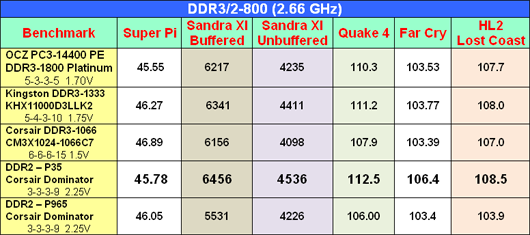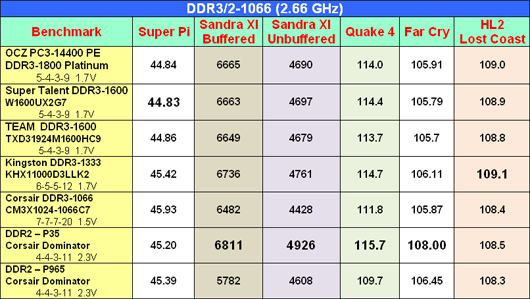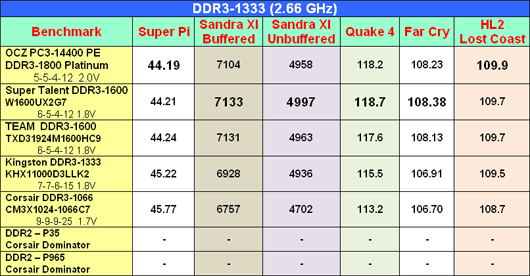DDR2/DDR3 Overlap Speeds
In Kingston Launches Low-Latency DDR3, memory performance was compared at the DDR2 and DDR3 overlap speeds of 800 and 1066 MHz. With the retesting of memory in the new test bed it was worthwhile to compare memory, at least in this initial review, at the overlap speeds. This presents the opportunity of seeing how top DDR3 performance compares to the DDR2 performance with which you are familiar.
At 800 MHz, DDR2 is capable of 3-3-3 timings, while DDR3 is limited to CAS 5 in the ASUS P5K3 Deluxe BIOS. With that severe timing limitation, which is the result of the much higher speeds available with DDR3, the DDR2 memory is generally the fastest solution. The latest Elpida (Kingston) and Micron Z9 (OCZ) chips still beat the last generation DDR2 in the Intel P965 motherboard in almost every case. However, the latest P35 Intel chipset driving DDR2 instead of DDR3 is still the best performer at 800 MHz - simply due to the advantage of CAS 3 compared to CAS 5 timings.
At the overlap speed of 1066 DDR2 still enjoys a timings advantage over DDR3 on the ASUS board. The fastest DDR3 CAS timings of 5 limits the best DDR3 timings to 5-4-3 compared to DDR2 at 4-4-3 with Corsair Dominator DDR2. Even with the timings advantage, DDR2 is only truly the better performer when running on the P35 chipset. The advantage for DDR2 here is very small to non-existent, however, as DDR3 results top a couple of the P35 DDR2-1066 benchmarks and the Elpida and Micron Z9 generally outperform DDR2/P965 across the board.
By 1333 the timing advantage for DDR2 is gone and DDR3 pulls clearly in the lead in all benchmarks. The Micron Z9-based memories top the 1333 performance charts in all benchmarks, and this is just the beginning of a range that extends to DDR3-2000 and beyond for some of these memories. Keep in mind that memory in these three charts are all running at the same 2.66GHz CPU speed, and that only the memory speed has been changed by varying ratios. It should be obvious in these results why Intel elected to move to the 1333 bus and the faster speeds of DDR3 memory.
Going up from DDR3-1333 to DDR3-1600, DDR3-2000 and beyond further extends the performance lead for DDR3 as you will see in the next three pages of DDR3 performance results on the same benchmarks. With the change to the 3.0GHz processor speed to allow memory tests through DDR3-2000 at the same CPU speed, all benchmarks were rerun at the 3.0GHz CPU speed with 800, 1066, and 1333 memory speeds. This allows a linear comparison of DDR3 memory at all available memory speeds while the CPU speed remains at a constant 3.0GHz.
For this and subsequent DDR3 reviews, DDR3 performance will be compared at 800, 1066, 1333, 1600, 2000, and the highest memory speed for the tested memory. 1000 is the logical base for the 333 strap, as is 1666, but current ratios limit realistic benchmarking to the 1066 and 1600 reference speeds. We will change to the 1000 and 1666 speed options as soon as available memory ratios in the BIOS allow a more convenient means to select 1000 and 1666 as memory speeds at a consistent processor speed. Those ratios are not currently available in the ASUS P5K3 Deluxe BIOS - or in any other DDR3 compatible motherboards at present.
In Kingston Launches Low-Latency DDR3, memory performance was compared at the DDR2 and DDR3 overlap speeds of 800 and 1066 MHz. With the retesting of memory in the new test bed it was worthwhile to compare memory, at least in this initial review, at the overlap speeds. This presents the opportunity of seeing how top DDR3 performance compares to the DDR2 performance with which you are familiar.
 |
| Click to enlarge |
At 800 MHz, DDR2 is capable of 3-3-3 timings, while DDR3 is limited to CAS 5 in the ASUS P5K3 Deluxe BIOS. With that severe timing limitation, which is the result of the much higher speeds available with DDR3, the DDR2 memory is generally the fastest solution. The latest Elpida (Kingston) and Micron Z9 (OCZ) chips still beat the last generation DDR2 in the Intel P965 motherboard in almost every case. However, the latest P35 Intel chipset driving DDR2 instead of DDR3 is still the best performer at 800 MHz - simply due to the advantage of CAS 3 compared to CAS 5 timings.
 |
| Click to enlarge |
At the overlap speed of 1066 DDR2 still enjoys a timings advantage over DDR3 on the ASUS board. The fastest DDR3 CAS timings of 5 limits the best DDR3 timings to 5-4-3 compared to DDR2 at 4-4-3 with Corsair Dominator DDR2. Even with the timings advantage, DDR2 is only truly the better performer when running on the P35 chipset. The advantage for DDR2 here is very small to non-existent, however, as DDR3 results top a couple of the P35 DDR2-1066 benchmarks and the Elpida and Micron Z9 generally outperform DDR2/P965 across the board.
 |
| Click to enlarge |
By 1333 the timing advantage for DDR2 is gone and DDR3 pulls clearly in the lead in all benchmarks. The Micron Z9-based memories top the 1333 performance charts in all benchmarks, and this is just the beginning of a range that extends to DDR3-2000 and beyond for some of these memories. Keep in mind that memory in these three charts are all running at the same 2.66GHz CPU speed, and that only the memory speed has been changed by varying ratios. It should be obvious in these results why Intel elected to move to the 1333 bus and the faster speeds of DDR3 memory.
Going up from DDR3-1333 to DDR3-1600, DDR3-2000 and beyond further extends the performance lead for DDR3 as you will see in the next three pages of DDR3 performance results on the same benchmarks. With the change to the 3.0GHz processor speed to allow memory tests through DDR3-2000 at the same CPU speed, all benchmarks were rerun at the 3.0GHz CPU speed with 800, 1066, and 1333 memory speeds. This allows a linear comparison of DDR3 memory at all available memory speeds while the CPU speed remains at a constant 3.0GHz.
For this and subsequent DDR3 reviews, DDR3 performance will be compared at 800, 1066, 1333, 1600, 2000, and the highest memory speed for the tested memory. 1000 is the logical base for the 333 strap, as is 1666, but current ratios limit realistic benchmarking to the 1066 and 1600 reference speeds. We will change to the 1000 and 1666 speed options as soon as available memory ratios in the BIOS allow a more convenient means to select 1000 and 1666 as memory speeds at a consistent processor speed. Those ratios are not currently available in the ASUS P5K3 Deluxe BIOS - or in any other DDR3 compatible motherboards at present.










25 Comments
View All Comments
MadBoris - Tuesday, July 31, 2007 - link
"Far Cry sees a similar increase from 112.90 at 800 to 121.94 at DDR2-2000"I think you meant DDR3-2000. Although DDR2-2000, would be nice. ;)
Wesley Fink - Tuesday, July 31, 2007 - link
Corrected.Spoelie - Tuesday, July 31, 2007 - link
...populating only one channel? With dual channel bandwidth exceeding double the bandwidth of the fsb, I'm curious as to how a single channel with equal or more bandwidth than the fsb would perform.Myrandex - Tuesday, July 31, 2007 - link
Eh I hate it when people run dual channel boards in a single channel config. I remember a laptop review of the new Turion X2 and they were running it in single channel mode with onboard video. Heck where I work they do that all the time in the ATM systems that they manufacture. They pay for the dual channel chipset, yet they configure it to run in single channel mode.YellowWing - Tuesday, July 31, 2007 - link
Thanks for keeping the CPU clock constant this time. We get the chance to see what the memory is adding without having to factor out the CPU clock changes. I look forward to new straps for a completely even test environment.Wesley Fink - Tuesday, July 31, 2007 - link
You're welcome. All of your suggestions on making this a better memory test platform were very helpful. We need 1600 and 2000 memory straps right now with DDR3 boards. I sincerely doubt that it even occurred to JEDEC and motherboard makers that we would be caring about DDR3-2000 this early in the development of DDR3. The memory speed development of DDR2 seems almost glacial by comparison.mostlyprudent - Tuesday, July 31, 2007 - link
Although I did not participate in the discussion of the last article, I did follow it and want to tip my hat to Wes (and really all the AT authors) for being willing to engage readers in the comments and apply the feedback and critiques offered. This is why, IMHO, AT has continued to get better and better over the years.qpwoei - Tuesday, July 31, 2007 - link
As a critic of the last article, I'd like to chime in and say well done on this one as well. Unfortunately, I don't think you'll be seeing any > 1:1 ratios on external chipsets (ie: non-IMC) for a while, if ever. The design issues for making > 1:1 ratios really outweigh the benefits, especially in a system where the memory bandwidth is already twice the FSB bandwidth.MadBoris - Tuesday, July 31, 2007 - link
Hey wesley,I also wanted to say thanks for the more apples to apples comparison with DDR2. I think this is really of utmost importance to most folks before we start comparing DDR3 among other DDR3 modules. As exciting as DDR3 is as a technology we still want to see the real world performance improvement over DDR2 to justify for ourselves any price increase with new purchases, let alone the three fold price increase. If I get 3 to 4 percent less performance for 1/3 the price then that is a good purchasing decision for me. All new memory suffers from these teething pains, I just wanted them quantifiable.
In further search for the real world comparison and the true advantages that DDR3 brings at it's current highest speeds comared to DDR2 at it's highest speeds(1066 in this case), I did have to flip back and forth between pages 4 and 7 several times. With page 4 using a 2.66 GHZ CPU clock frequency and page 7 using 3GHZ, a direct comparison in the benchmark numbers themselves wasn't possible due to the 10% CPU difference. Initially page 7 scores looked much better than page 4 until I factored in the 10% CPU difference. It took a few minutes to come to a method of distinguishing the real world advantage of DDR3 running at it's highest speeds, compared to DDR2 at it's higher speeds.
basically, I came to the conclusion if 1333 is where DDR3 starts to get it's legs and surpass DDR2(as you state on page 4). Page 4 doesn't actually show the 1333 speeds of DDR2 in the chart (as none exists), but you can see there is a minor advantage in the two games emerging over the previous chart with 1066 DDR2. So then comparing DDR3 at 1333 to DDR3 at highest speeds on page 7 gives me a rough estimate of the "real world" performance of DDR3 at it's highest speed over what DDR2 has it's highest speeds (with an additional 1% tossed in as advantage over 1066 ddr2). All this extrapolation was necessary due to the 10% CPU difference. Not complaing, just stating a fact in trying to get to the real world benefits if I was going to by a platform today, and having to justify the cost/performance ratio.
In the end, the real world benefit of DDR3 at it's highest speeds, compared to a P35 running DDR2 at it's highest speeds(both with fastest timings using 1333 as the cutoff where DDR2 is left behind) came out to about 3 - 5 percent real world gaming benefit in benchmarks of Far Cry and Quake 4. Obviously the synthetics showed much more, but they always do. All that of course is based on the reality that 1333 is where the performance shift takes place with the current fastest DDR2 and fastest DDR3, which is what I was after. To me, 3 - 5 percent definitely doesn't justify 3 times the cost of the memory yet, especially if a board supports both DDR2 and DDR3.
Anyway, thanks for making an apples to apples comparison more possible in this review, even though not exact, I could extrapolate the necessary info I wanted. I'm sure as latency continues to lower on DDR3, than all this additional frequency will be worth something beyond the current meager benefits over DDR2 at 1066.
indeed - Tuesday, July 31, 2007 - link
Is there any chance that we'll be seeing DDR2 1066 4GB packs with 2 modules any time soon?